If you’ve traveled abroad, chances are you used a translator on your phone to read a menu, ask for help, or make sure you’re buying the right ticket at a train station.
Technology broke down language barriers and made global interactions way easier than before. In ecommerce and services, this is a crucial development. Before, businesses could only target their local language, and perhaps English, leading to missed opportunities and frustration.
When communication breaks down, it’s hard to build strong relationships and grow.
Multilingual live chat solves this by enabling real-time conversations in multiple languages on your website and in messaging channels, bridging communication gaps with a global audience.
Providing support in your customers’ preferred language enhances their experience and boosts conversion rates. To achieve this, it’s important to know which features a multilingual live chat tool should have to meet your business needs.
Add multilingual live chat to your website and connect with customers worldwide!
Components of multilingual live chat
When you visit an international online store, the website often detects your IP address and automatically switches the text to your target language and currency. This makes browsing easier and reassures the shopper that you ship to their country.
Multilingual live chat software works in a similar way — it provides businesses with the tools they need to effectively communicate with a diverse customer base. It combines several key components to make multilingual conversations seamless:
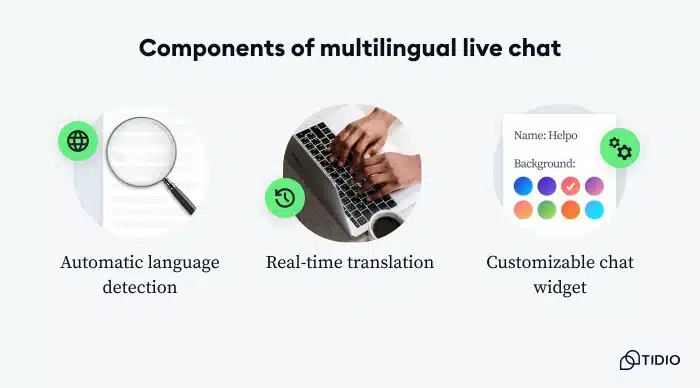
- Automatic language detection — identifies the user’s preferred language based on their location or settings
- Real-time translation — translates messages instantly between the business and the customer
- Customizable chat widget — allows businesses to select from multilanguage options within the chat interface
How does multilingual live chat work?
When a customer initiates a chat, the system detects their preferred language automatically or adjusts based on their selection. This updates the chat widget to the customer’s target language to display default and custom phrases.
During the conversation, real-time machine translation tools convert messages between the business and the agent. The tool also uses your internal knowledge base to provide accurate, context-specific support, ensuring smooth communication across language barriers.
But how do you pick the best multilingual chat option for your business requirements?
Here’s what to look for.
How to choose the best multilingual live chat for your needs
When selecting a multilingual chat solution, it’s important to ensure that the platform supports seamless communication with a diverse client base. This means your chat system should go beyond basic machine translation to provide an effective customer experience.
Here are seven multilingual chat features to look for:
1. True multilanguage support
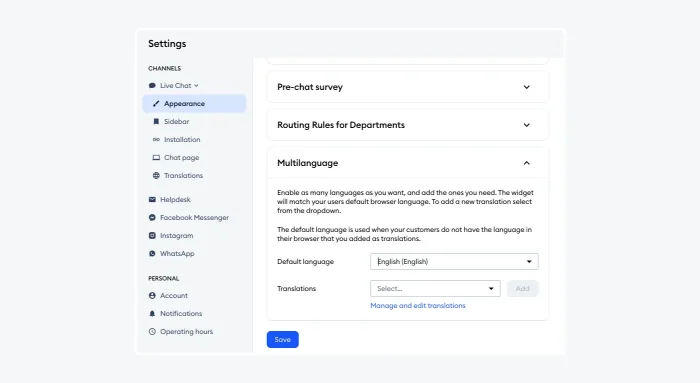
Multilanguage support is more than translating text — it’s also about offering a user interface that accommodates multiple languages across the entire chat experience. From your chat widget to pre-set responses, the entire platform should adapt to different languages.
Imagine a customer in Spain visiting a French website. The website automatically translates to Spanish, and so does the proactive chat greeting. They start a chat, and the entire widget is in their language. Even the AI chatbot that greeted them can help resolve many of their requests in Spanish without ever needing an agent.
This is how your multilingual customer support system should work — by covering multiple aspects of client interaction, ensuring that users can easily use the chat window, read notifications, and interact with agents in their preferred language.
This smooth experience is made possible by features like automatic language detection, which identifies the user’s preferred language based on their browser settings, location, or previous interactions. In turn, customers receive instant support in their native language, enhancing customer engagement and providing a more personalized experience from the start.

Software recommendation —Tidio offers a seamless solution for websites with multiple language options. It contains multilingual chat widget functionality, pre-translated language packs, automatic browser language detection, and the ability to use AI and rule-based chatbots that can be set to talk to customers in their local language.
Read more: Learn all about multilingual chatbots and how to create one for your business.
Enhance customer experience and break language barriers with multilingual live cha
2. Multilanguage flows
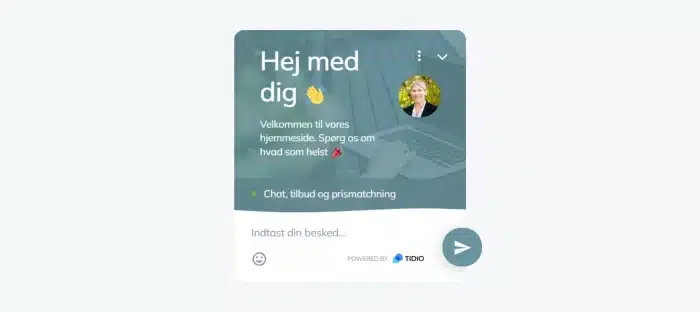
A multilanguage flow feature allows businesses to automate customer interactions by detecting a visitor’s preferred language and delivering messages that feel personal and relevant. It ensures that customers, no matter where they’re from, receive communication in their native language.
After recognizing the visitor’s browser language settings, the system then automatically adjusts the flow to match their language. Not only does this enhance the user experience, but it also boosts customer satisfaction by making interactions feel more personal.
Setting up multilanguage flows in Tidio is simple and effective, allowing you to create flows that send automated messages in multiple languages. Doing it is pretty straightforward: simply place the Language condition after the flow’s trigger, and from there, you can customize message paths for different languages.
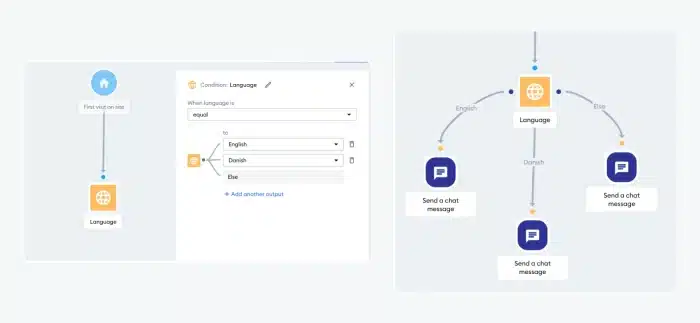
Read more: Learn how to change and add languages in Tidio. Also, here’s all you need to know about multilingual chatbots and how to create one for your business.
3. AI chatbots with real-time translation
A key feature of multilingual live chat is real-time translation. This allows businesses to communicate instantly with customers in their language — even if you don’t speak it.
Advanced AI-powered systems allow you to use chatbots that automatically switch to the customer’s target language. Its speech improves over time, offering more reliable translations with each conversation.
For example, Tidio’s Lyro AI chatbot is currently able to translate and respond in twelve languages, including English, French, Italian, Spanish, Portuguese, and German. What’s also great is that the data sources Lyro uses to answer customer questions do not have to be updated manually. They’ll get translated automatically to the language in question as soon as the visitor sends their message.
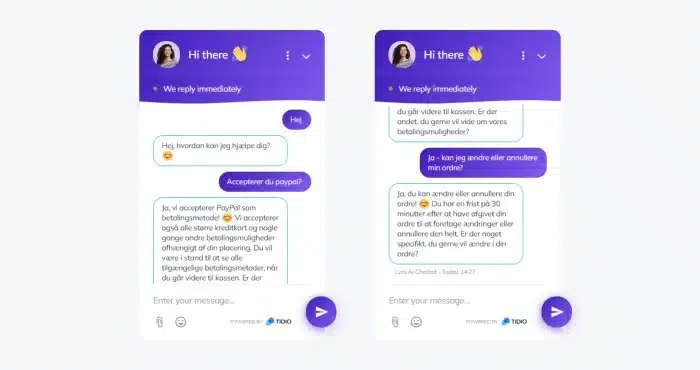
You should note that you need to set and/or add languages in the multilanguage widget settings in order for it to work.
Once you do that, you’ll be able to find the list of languages supported by Lyro in its Personality section.
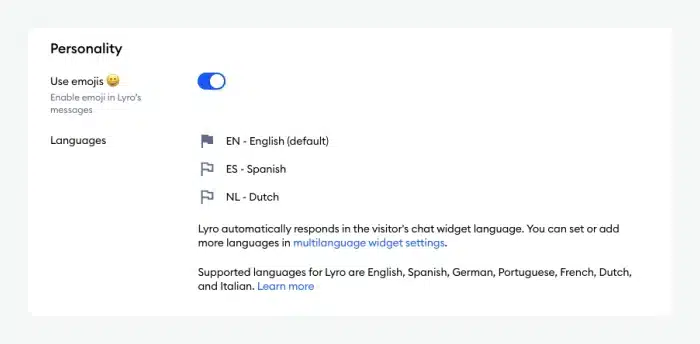
This feature is available for Plus subscribers, but you can test Lyro for free to see it in action on your website.
Read more: Here’s all you should know about Lyro’s multilanguage support.
4. Panel localization
When selecting a multilingual live chat system, panel localization is another critical feature to consider. It allows chat operators to interact with the system’s admin panel in their preferred language, improving usability and working efficiency. In environments with teams spread across multiple regions or countries, the ability to localize the admin panel ensures that operators can work without language barriers, reducing misunderstandings and increasing productivity.
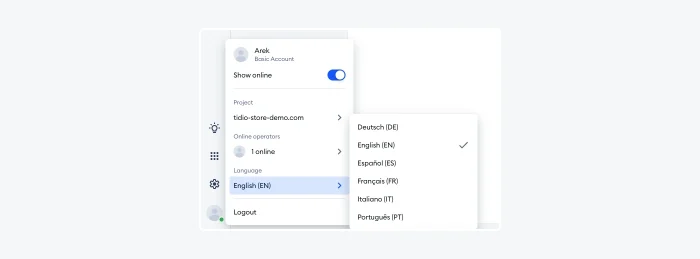
Tidio offers a simple and user-friendly localization feature that supports multiple languages, including English, German, French, Spanish, Italian, and Portuguese. Changing the language of the Tidio panel is a quick process — operators can easily select their desired language by clicking on their avatar in the bottom-left corner of the dashboard.
Once a language is chosen, the localized version of the panel will only be visible to the agent who made the changes. In other words, each agent needs to make the changes in their own panel. This flexibility allows teams in diverse linguistic regions to personalize their panel without affecting other users’ settings.
5. Confirm whether multilingual chat is a built-in feature or an add-on
When evaluating multilingual live chat solutions, it’s important to determine whether translation and language detection are built-in features or require third-party add-ons.
A platform with built-in multilingual capabilities provides a more seamless experience as there are no external tools to integrate, reducing the risk of compatibility issues and ensuring faster setup. Additionally, it offers more consistent updates and support, with all features working harmoniously within a single system.
A common multilingual add-on typically functions as an external add-on or API that provides translation services for live chat platforms. For example, the LiveChat platform offers the Message Translator and AI Translator add-ons which require additional pricing.
Options like these can introduce complexity, leading to slower performance and potential compatibility issues such as conflicts between the third-party tool and the main platform.
Additional drawbacks of using add-ons include:
- Inability to detect language nuances and context, leading to less accurate translations.
- Lack of localization, often resulting in direct one-on-one translations that feel unnatural.
- Outdated integrations, as add-ons may not be regularly updated by the provider.
So, always prioritize solutions that have these features integrated to ensure smoother communication and better overall functionality.
6. Department feature to route customers to language-specific teams

A multilingual live chat should offer a routing feature that allows users to select which language-speaking team they want to communicate with. That way, even if your chat widget is displayed in a default language, like English, visitors should be able to choose their preferred department based on language.
For example, users can opt to speak with agents fluent in Spanish, French, or other supported languages. This ensures customers are connected with the right support team, improving response times and providing a more personalized, culturally aware service that strengthens customer relationships.
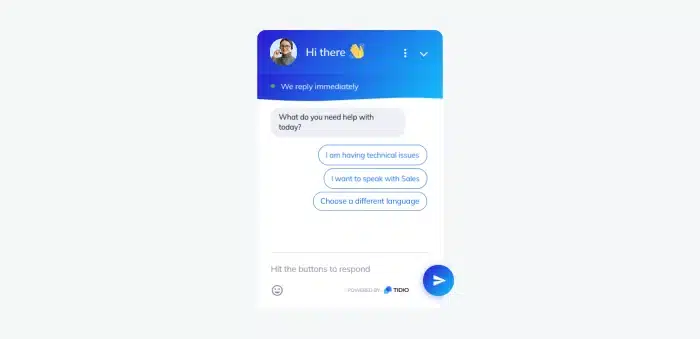
Tidio’s Departments feature allows businesses to streamline customer support by routing conversations to the appropriate team based on a visitor’s selected topic or language. This feature helps operators focus only on relevant chats, reducing unnecessary notifications and keeping inboxes organized. Visitors can choose a department through a pre-chat survey or be automatically routed via flow automation. This way, operators within a specific department are the only ones notified of incoming chats, ensuring faster response times.
7. Canned responses that are translated into every supported language
Having pre-translated canned responses for each target language is key to maintaining consistency across departments. It ensures customers get clear, reliable information no matter who they’re speaking to, minimizing the frustration that can come from mixed messages.
Plus, it speeds up response times and boosts agent efficiency by eliminating the need for manual translations, which also reduces the risk of human error. With this feature in place, agents can respond more quickly and accurately, delivering a smoother customer experience.
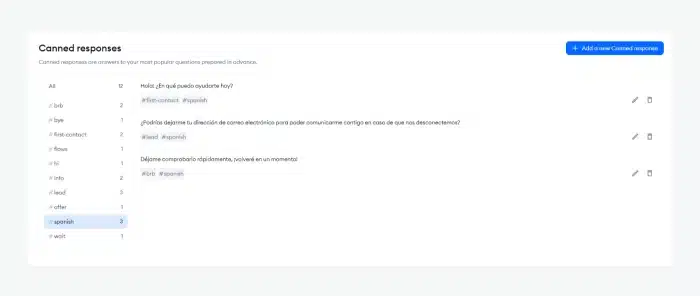
Tidio makes it easy to create canned responses in multiple languages, allowing businesses to respond quickly and consistently to customers worldwide. You can set up predefined responses for common inquiries, which can be organized by language using tags. This makes it easy for agents to find and use them during chats. Also, with the help of tags, businesses can categorize their responses by specific queries or departments, ensuring the right information is shared with the right customer every time.
By focusing on these key features, you can select a multilingual live chat solution that provides smooth, efficient communication and supports your business’s global growth.
With that out of the way, let’s check out the main benefits of using multilingual chats.
Business benefits of using multilingual live chat
To successfully cater to a diverse audience, businesses need to offer multilingual live chat as part of their customer service strategy. By allowing seamless communication across different languages, you’ll remove communication barriers and make your customer support more accessible and tailored to individual needs.
Let’s explore some of the key benefits of implementing multilingual live chat:
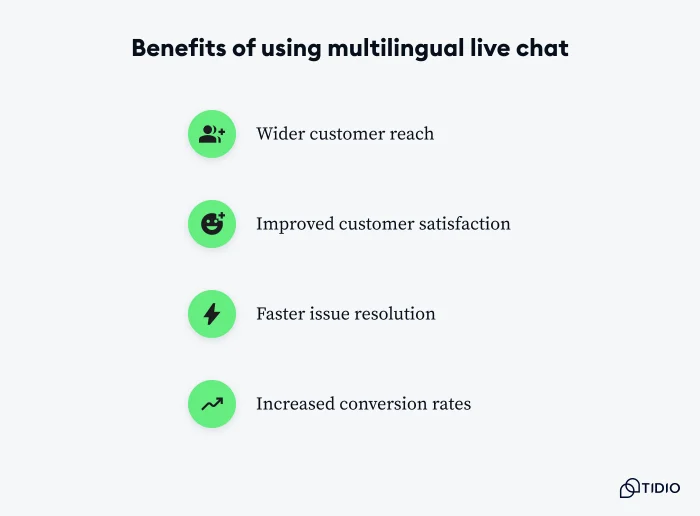
- Wider customer reach — by using multilingual chat, you can easily engage customers from different regions to expand your market and grow your business. Based on a survey done by CSA, 30% of consumers never buy from English-language sites, while another 29% rarely do.
- Improved customer satisfaction — by offering support in the customer’s preferred language, you create a more personalized and positive experience. According to a report by DeepL, 75% of respondents agreed that localized content notably enhances customer engagement.
- Faster issue resolution — the ability to instantly communicate with worldwide customers in their native language helps resolve queries quicker, reducing wait times and increasing efficiency.
- Increased conversion rates — clear communication leads to better customer engagement, resulting in higher conversion and retention rates. In fact, the REVIEWS.io platform experienced a 20% boost in conversions after translating their website to German.
Read more: Find out how Suitor managed to decrease average response times using Tidio.
Connect globally with leading multilingual live chat software
Tidio is a top multilingual live chat solution that prioritizes seamless communication with a global audience. It provides multilanguage support and automatic language detection, so your team can offer a personalized experience that bridges language barriers and enhances customer satisfaction.
Lyro, an AI-powered chatbot, detects languages automatically, understands context regardless of the language, and can seamlessly pass the conversation to a human agent when more personalized assistance is required.
Tidio’s easy-to-use interface and localization options allow businesses to provide support in various languages, making it an ideal solution for companies looking to connect with a diverse user base.
Register for a free trial today and give Tidio a try!
Experience seamless multilingual support with an AI-powered chatbot
Frequently Asked Questions
Multilingual live chat allows businesses to communicate with customers in multiple languages through real-time translation and language detection. It works by identifying the user’s preferred language and either routing the conversation to an agent who speaks that language or translating messages between the customer and agent to ensure clear communication.
Multilingual live chat is crucial for businesses with a global customer base. It helps overcome language barriers, improves customer satisfaction, and enhances engagement by offering support in the customer’s native language. This creates a more personalized experience, increasing the chances of conversions and customer loyalty.
Yes, most advanced multilingual live chat platforms offer smooth integration with CRMs, ecommerce platforms, and other business tools. This integration allows businesses to streamline workflows, access customer data, and provide a more personalized support experience.

